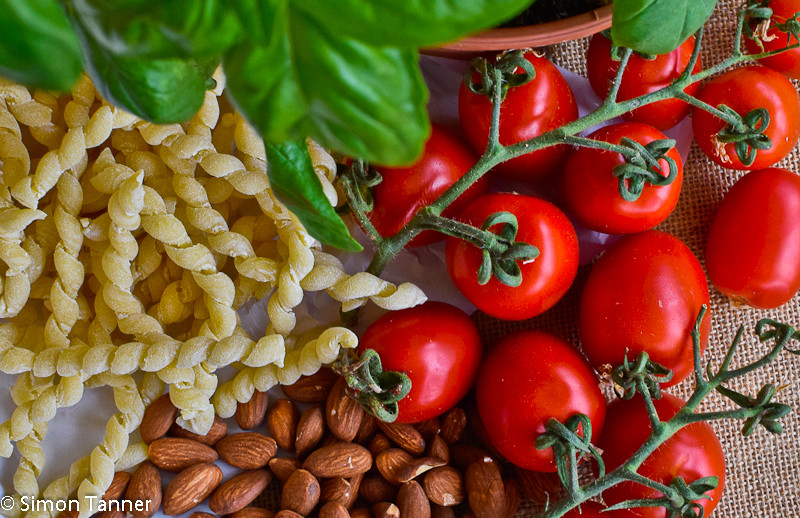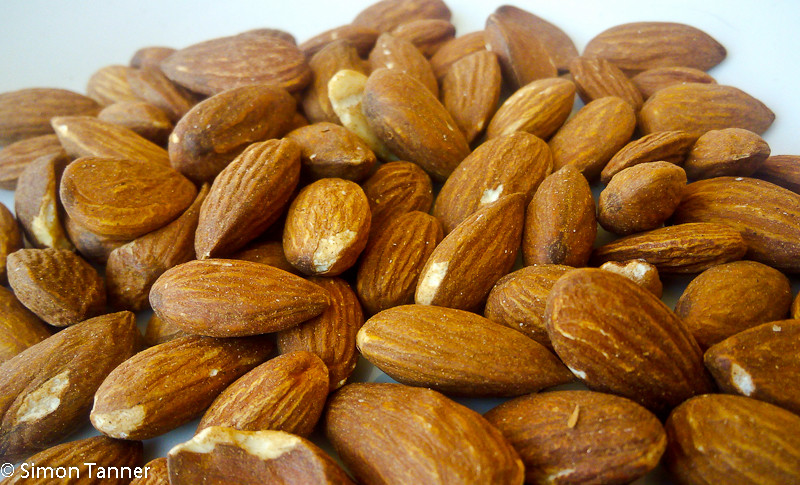 Toasted almonds, like drugs, can be dangerously addictive, even more addictive than capers from Stromboli. Here, they sell them slightly salted, dosed out into little plastic bags; again, rather like capers and drugs. They are however better for you than anything you are likely to buy down a shady alley, and a handful a day apparently brings great health benefits. Of course, if your family is anything like mine, managing to get your fair share either means burying them in the garden or buying them in industrial quantities. Almonds also play a central role in Sicilian cuisine, and although their use is mainly restricted to sweets, they are found in the occasional savoury recipe, such as today’s pesto.
Toasted almonds, like drugs, can be dangerously addictive, even more addictive than capers from Stromboli. Here, they sell them slightly salted, dosed out into little plastic bags; again, rather like capers and drugs. They are however better for you than anything you are likely to buy down a shady alley, and a handful a day apparently brings great health benefits. Of course, if your family is anything like mine, managing to get your fair share either means burying them in the garden or buying them in industrial quantities. Almonds also play a central role in Sicilian cuisine, and although their use is mainly restricted to sweets, they are found in the occasional savoury recipe, such as today’s pesto.
 People assume that Genoa has exclusive rights over pesto, but this is actually not the case. This version is from Trapani, and while it has the same base of basil, garlic, nuts and olive oil, it has no cheese in the mix. Above all, it has an important addition: tomatoes.
People assume that Genoa has exclusive rights over pesto, but this is actually not the case. This version is from Trapani, and while it has the same base of basil, garlic, nuts and olive oil, it has no cheese in the mix. Above all, it has an important addition: tomatoes.
Seeing as the recipe is from Trapani, I suggest using the pasta they serve it with on Sicily’s west coast, namely the loosely-coiled busiate. If (when, more like) you can’t find busiate, use casarecce, fusilli, trofie or bucatini.
And if you are ingredient-challenged to the point that you can’t find toasted almonds either, just use blanched ones and toast them yourself over a low heat in a frying pan with the tiniest amount of oil. Watch them closely and keep them moving about: they burn easily and with very little forewarning.
The tomato-almond ratio may seem skewed, but trust me. Once the tomatoes have been skinned, deseeded and left to drain, you’ll be left with half the original weight. Local recipes call for twice as much garlic, but even a hardened Sicilian adoptee like me finds such quantities overpowering. If you want to be authentic, and above all to smell authentic, go the whole hog and put in four or five cloves rather than two. While we’re on the subject of garlic, years of trial and error with Genoese pesto have led me to a compromise. Doing everything in a pestle and mortar is traditional, but a waste of time unless you have a marble model the size of a baptismal font, Ligurian olive oil and copious quantities of the small-leaved, highly aromatic local basil. Any other variety will be reduced to a dark, oxidised sludge before it becomes pesto. If you do it all in the food processor, the colour remains vibrant, but the garlic is chopped rather than reduced to a smooth paste, which leaves it overly pungent. Solution: bash the garlic in the mortar and blitz the other ingredients in the food processor. Admittedly, it’s still not even close to the freshly-made pesto you’ll find in a good trattoria in Genoa, but then again, nothing is. Trying pesto there is one of those experiences that sets a benchmark by which you will judge all other pestos. And none of them will ever be quite as good.
Anyway, leaving Liguria behind us, let’s get back down south to Trapani and our Sicilian version. This is really a summer dish, to be enjoyed when tomatoes and basil are at their best, and when you can get your hands on the season’s new garlic, which is still relatively mild. The only thing that is not very summery is the colour. Despite the vibrant green and red of the basil and tomatoes, it’s the almonds that decide the final outcome, which is a rather unprepossessing light brown. Once you’ve had a mouthful, however, you won’t care what colour it is.
These quantities give enough for four generous portions, possibly more; the pasta should be lightly coated rather than swimming in the sauce – it’s oil-heavy pesto, not light tomato salsa. If there’s any surplus, spread it on toasted sourdough, or use it to accompany grilled vegetables. Either way, do it quick – this is not a sauce that lasts more than a day or two, even in the fridge. Not that this is likely to be a problem; like me, you’ll probably end up eating what’s left in spoonfuls, straight from the bowl…
Serves 4:
- 400g pasta (preferably busiate, but see above)
- 700g ripe tomatoes
- 100g toasted almonds
- 2 cloves garlic, peeled
- Large sprig of fresh basil (about 40g-worth of leaves)
- 4-5 tablespoons extra virgin olive oil
- Sea salt, freshly ground black pepper
- Grated pecorino to serve (or if you can get it, pepper-flecked Sicilian pepato stagionato)
- Put a pan of water on to boil. Rinse the tomatoes, then cut a small cross in the base/tip of each one. Place in the boiling water for two minutes, then drain and leave until cool enough to handle. Peel the tomatoes, pulling away the skin starting from the cross, cut into four lengthways and cut out the core and seeds. Place the tomato fillets in a colander to drain further.
- Blitz the almonds in a food processor until powdery. Tip the almond powder out of the processor bowl into a dish and put to one side. Bash the garlic in a mortar with a pinch of salt until reduced to a paste. Put the basil leaves, garlic paste and half the oil into the food processor, and blitz until the basil is finely chopped. Add the almonds and tomatoes and process until smooth, adding the rest of the oil a bit at a time. Season to taste with salt and pepper and an extra drizzle of oil if you like.
- Meanwhile, cook the pasta. Serve with the sauce and grated pecorino.
A fruity white is perfect here, such as my beloved Sicilian Grillo. Aptly, some of the best ones come from the Trapani area.
 English
English
Good one!
Thanks Nuala!
I see you don’t monetize your website, don’t waste your traffic,
you can earn extra bucks every month. You can use the
best adsense alternative for any type of website (they approve all websites),
for more info simply search in gooogle: boorfe’s tips
monetize your website
passioneat.it is fantastic, i will come back here for sure
webyx1